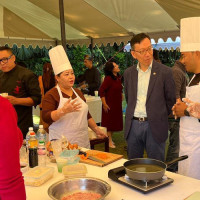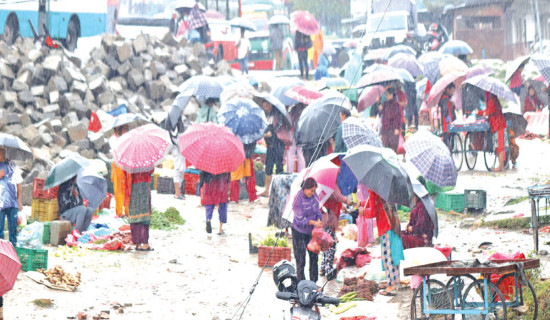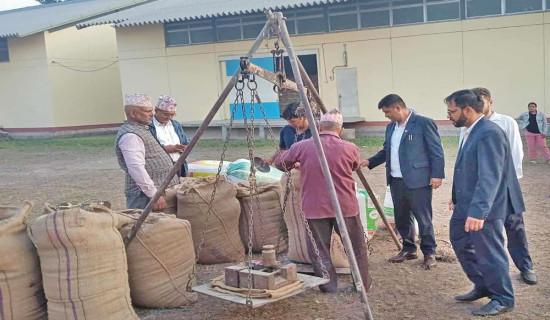- Sunday, 9 November 2025
Gundruk gaining space in grocery stores
Kathmandu, Aug. 22: An integral part of Nepali traditional cuisine, gundruk—dried form of green leafy vegetable, is gaining renewed popularity across all social classes and is even making its way into high-end culinary establishments.
Traditionally made by fermenting leafy greens such as mustard or rayo, radish leaves, or cauliflower greens, gundruk has long been a staple in most Nepali households. Known for its unique sour taste, it is commonly prepared as a curry or used as a pickle in everyday meals.
While it has deep roots in rural and poor households—valued for its ability to be preserved and consumed during vegetable-scarce and highly expensive months—gundruk is no longer seen as just food for the underprivileged. Today, it is being embraced by wealthier families as well, thanks to its nutritional benefits and distinct taste.
Municipalities branding gundruk
Previously prepared primarily for household consumption, farmers in some municipalities are now preparing gundruk commercially after rural municipalities made arrangements for its sale.
Some municipalities, including Rong Rural Municipality of Ilam and Kanepokhari Rural Municipality of Morang are promoting gundruk, branding it by introducing special programmes.
Chairman of Rong Rural Municipality Mani Kumar Syangbo said that the rural municipality has been branding the traditional dishes, gundruk and sinki, for the past three years.
He said that the branding has been started commercially to establish gundruk, which is prepared from vegetables produced in the village, as the specialty of Rong Rural Municipality.
"The previous local government had not shown interest in the production and marketing of gundruk. The gundruk produced by farmers was going to waste due to lack of attention from government agencies. So Rong Rural Municipality has branded gundruk to improve the living standard of the locals," he told The Rising Nepal.
Over the past few years, the rural municipality has been actively collecting and processing green leafy vegetables from local farmers' fields with the help of cooperatives, transforming them into packets of gundruk. The brand 'Rong Gundruk' is gaining popularity in Nepali grocery stores," he said.
The successful branding and market access have made it a sought-after item both locally and internationally, said Syangbo.
"Currently, two factories, one of the rural municipality and another in the private sector, have been preparing gundruk commercially for the past two years. These two factories are producing about 1,500 kg of gundruk annually," he said.
Similarly, two other factories being constructed by the rural municipality have reached the final stage of construction and will operate within few months, he said.
Once all four factories, two currently operating and two under construction, are operational, about 5,000 kg of gundruk can be produced annually,’ said chairman Syangbo.
He said the factories constructed by the rural municipality are being operated by the cooperatives.
According to him, the factory purchases green leaves from the farmers when the price drops below Rs. 20 per kilo in the market for preparing gundruk. When the price goes up, it encourages farmers to sell it on their own.
The agro processing factory is not only preparing gundruk, it also processing bitter gourd, stinging nettle and other agro products, he said.
Costs up to Rs. 1,000 per kg in wholesale
He said that the gundruk produced by these factories is hygienic and of good quality as they have received quality certificates from the government's Food Technology and Quality Control Office.
The gundruk produced here is being exported by traders to different countries, including Canada, America and Australia through cargos.
"A kg of gundruk is being sold at Rs. 1,000 in wholesale. Around 12-22 kg of green leaves based on their quality is needed to prepare a kg of quality gundruk," Syangbo said.
He urged the government to pay attention to use branded gundruk strictly in restaurants, hotels, including star-hotels, considering people's health and preserving the indigenous food.
"If the policy is introduced to consume branded gundruk in restaurants and hotels, there is huge potential for its production and sale internationally," he said.
According to the information officer of the Kalimati Fruit and Vegetable Market Development Board Binaya Shrestha, gundruk usually comes to Kalimati market from Dolakha, Kavrepalanchowk and Dhading.
However, as gundruk enters the market in very small quantities, he said that the KFVMDB does not keep statistics on the quantity of gundruk supply into the market.
"Gundruk is made in almost all households in rural areas and in Kathmandu too; they make gundruk by purchasing mustard and other green leaves. That is why gundruk is sold in very small quantities in the market," Shrestha said.
He said that KFVMDB has been displaying the daily rate of gundruk sold in the market. Bhagwan Chandra Upreti, a trader at Kalimati market, said that gundruk from Ilam is supplied to Kalimati market.
He said that traders in Kalimati market prepare their own gundruk and sell it when the green leaves are not selling.
According to him, gundruk is sold at Rs. 300-400 per kg in Kalimati market.
Upreti said that gundruk is widely consumed in party venues and is also used in star hotels as well. "Gundruk is mostly used in dishes in Thakali hotels and restaurants," he added.
















